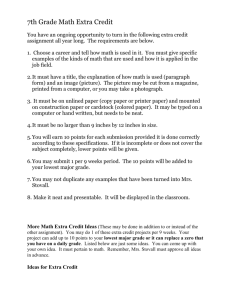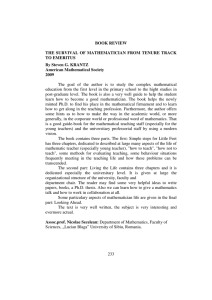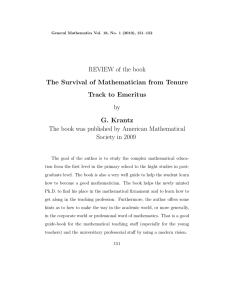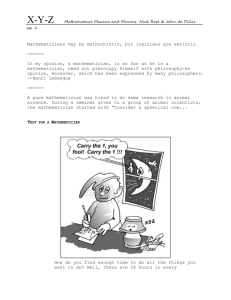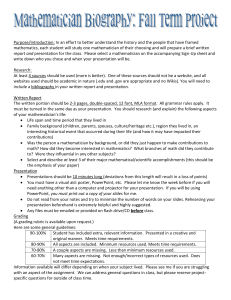I Foolproof: A Sampling of Mathematical Folk Humor
advertisement
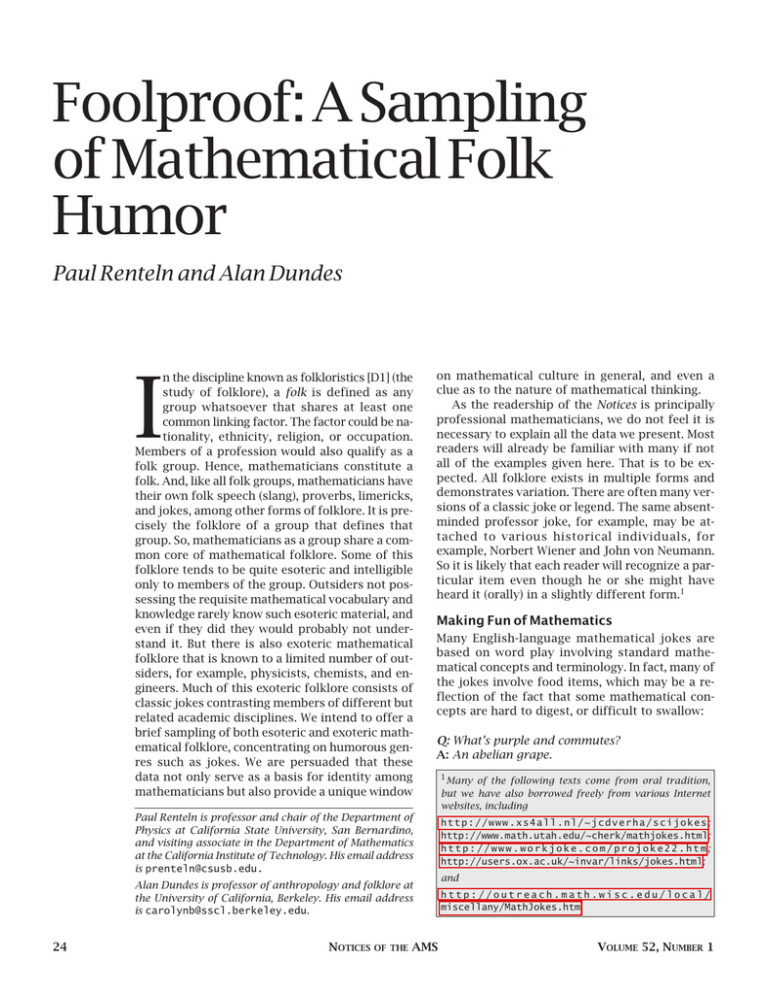
Foolproof: A Sampling of Mathematical Folk Humor Paul Renteln and Alan Dundes I n the discipline known as folkloristics [D1] (the study of folklore), a folk is defined as any group whatsoever that shares at least one common linking factor. The factor could be nationality, ethnicity, religion, or occupation. Members of a profession would also qualify as a folk group. Hence, mathematicians constitute a folk. And, like all folk groups, mathematicians have their own folk speech (slang), proverbs, limericks, and jokes, among other forms of folklore. It is precisely the folklore of a group that defines that group. So, mathematicians as a group share a common core of mathematical folklore. Some of this folklore tends to be quite esoteric and intelligible only to members of the group. Outsiders not possessing the requisite mathematical vocabulary and knowledge rarely know such esoteric material, and even if they did they would probably not understand it. But there is also exoteric mathematical folklore that is known to a limited number of outsiders, for example, physicists, chemists, and engineers. Much of this exoteric folklore consists of classic jokes contrasting members of different but related academic disciplines. We intend to offer a brief sampling of both esoteric and exoteric mathematical folklore, concentrating on humorous genres such as jokes. We are persuaded that these data not only serve as a basis for identity among mathematicians but also provide a unique window 24 on mathematical culture in general, and even a clue as to the nature of mathematical thinking. As the readership of the Notices is principally professional mathematicians, we do not feel it is necessary to explain all the data we present. Most readers will already be familiar with many if not all of the examples given here. That is to be expected. All folklore exists in multiple forms and demonstrates variation. There are often many versions of a classic joke or legend. The same absentminded professor joke, for example, may be attached to various historical individuals, for example, Norbert Wiener and John von Neumann. So it is likely that each reader will recognize a particular item even though he or she might have heard it (orally) in a slightly different form.1 Making Fun of Mathematics Many English-language mathematical jokes are based on word play involving standard mathematical concepts and terminology. In fact, many of the jokes involve food items, which may be a reflection of the fact that some mathematical concepts are hard to digest, or difficult to swallow: Q: What’s purple and commutes? A: An abelian grape. 1 Many of the following texts come from oral tradition, but we have also borrowed freely from various Internet websites, including Paul Renteln is professor and chair of the Department of Physics at California State University, San Bernardino, and visiting associate in the Department of Mathematics at the California Institute of Technology. His email address is prenteln@csusb.edu. http://www.xs4all.nl/~jcdverha/scijokes; http://www.math.utah.edu/~cherk/mathjokes.html; http://www.workjoke.com/projoke22.htm; http://users.ox.ac.uk/~invar/links/jokes.html; Alan Dundes is professor of anthropology and folklore at the University of California, Berkeley. His email address is carolynb@sscl.berkeley.edu. http://outreach.math.wisc.edu/local/ miscellany/MathJokes.htm. NOTICES OF THE AMS and VOLUME 52, NUMBER 1 There are several other variants of this joke: Q: What’s purple, commutes, and is worshipped by a limited number of people? A: A finitely-venerated abelian grape. Q: What is lavender and commutes? A: An abelian semigrape. Q: What is purple and all of its offspring have been committed to institutions? A: A simple grape: it has no normal subgrapes. Q: What’s purple, round, and doesn’t get much for Christmas? A: A finitely presented grape. Q: What is green and homeomorphic to the open unit interval? A: The real lime. Q: What’s yellow, linear, normed, and complete? A: A Bananach space. Q: What do you call a young eigensheep? A: A lamb, duh! Q: What’s the value of a contour integral around Western Europe? A: Zero, because all the Poles are in Eastern Europe. Addendum: Actually, there ARE some Poles in Western Europe, but they are removable! 2 Q: What’s an abelian group under addition, closed, associative, distributive, and bears a curse? A: The Ring of the Nibelung. Q: Why did the mathematician name his dog “Cauchy”? A: Because he left a residue at every pole. Q: What’s nutritious and commutes? A: An abelian soup. Q: What is a topologist? A: Someone who cannot distinguish between a doughnut and a coffee cup. Q: What’s hot, chunky, and acts on a polygon? A: Dihedral soup. Q: Why didn’t Newton discover group theory? A: Because he wasn’t Abel. Q: What’s sour, yellow, and equivalent to the Axiom of Choice? A: Zorn’s Lemon. There are thousands of lemmas in mathematics, so in principle the same word play would work on any one of them, yet this joke based on Zorn’s lemma continues to be popular. Why should this be so? The reason for this becomes clearer when we recall that the Axiom of Choice can be used to prove many counterintuitive results in set theory, such as the Banach-Tarski paradox. This leads some mathematicians to reject the Axiom of Choice. Yet because it is so useful (and because it seems so innocuous at first glance), many mathematicians accept it, but with strong reservations. They find it distasteful, or unpalatable, or, if you will, a bitter fruit. Here is another one, even more revealing: Q: What is brown, furry, runs to the sea, and is equivalent to the Axiom of Choice? A: Zorn’s lemming. Lemmings are known to follow each other blindly into the sea, where they drown. The implication of this version seems to be that mathematicians who rely upon the Axiom of Choice are all lemmings who blindly follow one another and who may all be headed for intellectual death. JANUARY 2005 Q: What do you get if you cross an elephant and a banana? A: |elephant|*|banana|*sin(theta). 2 There are several shaggy dog stories based on wordplay in complex analysis. For example: A bunch of Polish scientists decided to flee their repressive government by hijacking an airliner and forcing the pilot to fly them to a western country. They drove to the airport, forced their way on board a large passenger jet, and found there was no pilot on board. Terrified, they listened as the sirens got louder. Finally, one of the scientists suggested that since he was an experimentalist, he would try to fly the aircraft. He sat down at the controls and tried to figure them out. The sirens got louder and louder. Armed men surrounded the jet. The wouldbe pilot’s friends cried out, “Please, please take off now!!! Hurry!!!” The experimentalist calmly replied, “Have patience. I’m just a simple pole in a complex plane.” A group of Polish tourists is flying on a small airplane through the Grand Canyon on a sightseeing tour. The tour guide announces: “On the right of the airplane, you can see the famous Bright Angle Falls.” The tourists leap out of their seats and crowd to the windows on the right side. This causes a dynamic imbalance, and the plane violently rolls to the side and crashes into the canyon wall. All aboard are lost. The moral of this episode is: always keep your poles off the right side of the plane. For a classification of shaggy dog stories, including ones with punch lines based on “an Axiom of Science”, see [B]. NOTICES OF THE AMS 25 Q: What do you get if you cross a mosquito with a mountain climber? A: You can’t cross a vector with a scalar. or this variation Q: What do you get when you cross a mountain goat and a mountain climber? A: Nothing—you can’t cross two scalars.3 Q: What is a compact city? A: It’s a city that can be guarded by finitely many nearsighted policemen.4 Q: What’s a polar bear? A: A rectangular bear after a coordinate transform. Q: What goes “Pieces of seven! Pieces of seven!” A: A parroty error. Q: What’s big, grey, and proves the uncountability of the reals? A: Cantor’s diagonal elephant.5 4 Some mathematicians are so concerned about precision that they feel compelled to correct the mathematics in the jokes themselves. The following email comment on this joke appeared at http://www.xs4all.nl/~jcdverha/ scijokes/1_6.html: From: http://wheierman# NoSpam.corunduminium.com (Will Heierman): Recently, I read the following riddle on a math joke website. It was attributed to Peter Lax. “What is a compact city?” “A city that can be guarded by a finite number of nearsighted policemen.” However, I doubt that he would make such a mistake. Moreover, he was my advisor when I was a graduate student, and I actually recall a conversation with him regarding this anecdote. It did not go exactly like this (but this makes a better story): “Dr. Lax, wouldn’t it be better to say that a compact city is one that can be guarded by a finite number of policemen, no matter how nearsighted they are?” “That’s not any better, really, for if the nth policeman could only see a distance of 1/2(n+2) , no finite number of them could guard even [0, 1] !” “Wow! How do we handle this?” “I might reword it slightly: A compact city is one which can be guarded by a finite number of policemen, no matter how nearsighted a policeman is.” 5 For a discussion of the significance of other jokes in the elephant cycle, see [AD]. OF THE Q: What is clear and used by trendy sophisticated engineers to solve other differential equations? A: The Perrier transform. Q: Why can fish from the United States enter Canadian waters without a passport? A: This is permitted by the Law of Aquatic reciprocity! Q: Why are topologists especially prone to malaria? A: This disease comes from the Tietze fly!! 6 For further discussion of cross breed riddles, see [AH]. NOTICES Q: What is hallucinogenic and exists for every group with order divisible by pk ? A: A psilocybin p-subgroup. Q: Who knows everything there is to be known about vector analysis? A: The Oracle of del phi! Q: Why can’t you grow wheat in Z/6Z ? A: It’s not a field. 26 Q: What is very old, used by farmers, and obeys the fundamental theorem of arithmetic? A: An antique tractorization domain. Q: What is often used by Canadians to help solve certain differential equations? A: The Lacross transform. Q: What’s a dilemma? A: A lemma that produces two results. 3 Q: What is gray and huge and has integer coefficients? A: An elephantine equation. Q: Why do truncated Maclaurin series fit the original function so well? A: Because they are “Taylor” made. Q: What is locally like a ring and very evil? A: A devilish scheme. Q: What is a proof? A: One-half percent of alcohol. Q: Can you prove Lagrange’s Identity? A: Are you kidding? It’s really hard to prove the identity of someone who’s been dead for over 150 years! Q: What is black and white ivory and fills space? A: A piano curve. Q: What’s polite and works for the phone company? A: A deferential operator. Q: What does an analytic number theorist say when he is drowning? A: Log-log, log-log, log-log, …. 6 This joke contains an epidemiological error and should more correctly read “Why are topologists especially prone to sleeping sickness?”, as it is sleeping sickness, not malaria, that is spread by the Tsetse fly. AMS VOLUME 52, NUMBER 1 Q: What does a topologist call a virgin? A: Simply connected.7 following text shows that mathematicians are so clever that they can imagine a lightbulb that changes itself! Some joking questions are adaptations of standard folkloristic forms. The question “How many xxxx’s does it take to change a lightbulb” has several answers [D2], including the following: Q: How many topologists does it take to change a lightbulb? A: Just one, but what will you do with the doughnut? Q: How many number theorists does it take to change a lightbulb? A: This is not known, but it is conjectured to be an elegant prime. Q: How many geometers does it take to screw in a lightbulb? A: None. You can’t do it with a straightedge and compass. Q: How many analysts does it take to screw in a lightbulb? A: Three. One to prove existence, one to prove uniqueness, and one to derive a nonconstructive algorithm to do it. Q: How many Bourbakists does it take to replace a lightbulb? A: Changing a lightbulb is a special case of a more general theorem concerning the maintenance and repair of an electrical system. To establish upper and lower bounds for the number of personnel required, we must determine whether the sufficient conditions of Lemma 2.1 (Availability of personnel) and those of Corollary 2.3.55 (Motivation of personnel) apply. If and only if these conditions are met, we derive the result by an application of the theorems in Section 3.1123. The resulting upper bound is, of course, a result in an abstract measure space, in the weak-* topology. Q: How many mathematicians does it take to screw in a lightbulb? A: 0.999999…. In addition to making fun of beginning mathematics students who have difficulty grasping the equality 0.9999 · · · = 1 , this joke also shows how mathematics is essentially a solitary endeavor, as it only takes one mathematician to do it. This can be contrasted with many of the other standard answers to this question, which demonstrate that groups of people are often required. In fact, the 7 Here, again, the jokester reveals a lack of understanding of either mathematics or anatomy. JANUARY 2005 Q: How many lightbulbs does it take to change a lightbulb? A: One, if it knows its own Gödel number. This joke also expresses the fear that mathematics itself may be inconsistent (and perhaps even lead to paradoxes), as Gödel numbers were used by Gödel to prove his two celebrated incompleteness theorems, both of which shook the foundations of mathematics. The same anxiety surfaces in the following parody of the traditional joke: “Why did the chicken cross the road? To get to the other side.” Q: Why did the chicken cross the road? A: Gödel: It cannot be proved whether the chicken crossed the road. Some other answers to this question provided by famous mathematicians include: Q: Why did the chicken cross the road? A: Erdös: It was forced to do so by the chicken-hole principle. Q: Why did the chicken cross the road? A: Riemann: The answer appears in Dirichlet’s lectures. Q: Why did the chicken cross the road? A: Fermat: It did not fit on the margin on this side. A good mathematician always looks for possible counterexamples to unproved conjectures. Here is an amusing variant of the chicken crossing joke, demonstrating that the notion of “other side” is not always as straightforward as it seems: Q: Why did the chicken cross the Möbius strip? A: To get to the other–er…. If you cannot prove the theorem, prove a different one: Q: Why did the chicken cross the Möbius strip? A: To get to the same side. Although puns and one-liners occur orally, modern folklore is transmitted by photocopier, email, and the Internet, frequently in the form of lists [DP]. An example of this form is the following “Top Ten Excuses for Not Doing Homework”: • I accidentally divided by zero and my paper burst into flames. NOTICES OF THE AMS 27 • Isaac Newton’s birthday. • I could only get arbitrarily close to my textbook. I couldn’t actually reach it. • I have the proof, but there isn’t room to write it in this margin. • I was watching the World Series and got tied up trying to prove that it converged. • I have a solar-powered calculator and it was cloudy. • I locked the paper in my trunk, but a fourdimensional dog got in and ate it. • I couldn’t figure out whether i am the square of negative one or i is the square root of negative one. • I took time out to snack on a doughnut and a cup of coffee [and] I spent the rest of the night trying to figure which one to dunk. • I could have sworn I put the home work inside a Klein bottle, but this morning I couldn’t find it. Every mathematician relies on the truth of prior propositions proved by other mathematicians, and it is ordinarily impossible for a person to check the validity of every proof upon which his work is based. For this reason, mathematicians place tremendous emphasis on the correctness of mathematical proofs. The following list of proof techniques hints at the anxieties felt by many mathematicians regarding the degree to which mathematical truth is dependent upon the trustworthiness of previous results. This anxiety is exacerbated by the fact that some mathematicians have a less rigorous proof style than other mathematicians. Proof by vigorous handwaving: Works well in a classroom or seminar setting. Proof by forward reference: Reference is usually to a forthcoming paper of the author, which is often not as forthcoming as at first. Proof by funding: How could three different government agencies be wrong? Proof by example: The author gives only the case n = 2 and suggests that it contains most of the ideas of the general proof. Proof by deferral: “We’ll prove this later in the course.” 28 NOTICES OF THE Proof by intimidation: “Trivial.” Proof by seduction: “Convince yourself that this is true!” Proof by cumbersome notation: Best done with access to at least four alphabets and special symbols. Proof by exhaustion: An issue or two of a journal devoted to your proof is useful. Proof by obfuscation: A long plotless sequence of true and/or meaningless syntactically related statements. Proof by wishful citation: The author cites the negation, converse, or generalization of a theorem from the literature to support his claims. Proof by eminent authority: “I saw Karp in the elevator and he said it was probably NP-complete.” Proof by personal communication: “Eight-dimensional colored cycle stripping is NPcomplete [Karp, personal communication].” Proof by reduction to the wrong problem: “To see that infinite-dimensional colored cycle stripping is decidable, we reduce it to the halting problem.” How to prove it. Guide for lecturers. Proof by omission: “The reader may easily supply the details.” “The other 253 cases are analogous.” Proof by picture: A more convincing form of proof by example. Combines well with proof by omission. Proof by reference to inaccessible literature: The author cites a simple corollary of a theorem to be found in a privately circulated memoir of the Slovenian Philological Society, 1883. Proof by importance: A large body of useful consequences all follow from the proposition in question. Proof by accumulated evidence: Long and diligent search has not revealed a counterexample. Proof by cosmology: The negation of the proposition is unimaginable or meaningless. Popular for proofs of the existence of God. AMS VOLUME 52, NUMBER 1 Proof by mutual reference: In reference A, Theorem 5 is said to follow from Theorem 3 in reference B, which is shown to follow from Corollary 6.2 in reference C, which is an easy consequence of Theorem 5 in reference A. work may be based upon false premises. There are many fallacious proofs of the type purporting to prove that 1 = 2 . Here is just one example using the ever-popular trick of dividing by zero. Theorem. 3 = 4 . Proof. Suppose a + b = c. This can also be written as: 4a − 3a + 4b − 3b = 4c − 3c . After reorganizing: 4a + 4b − 4c = 3a + 3b − 3c . Take the constants out of the brackets: 4(a + b − c) = 3(a + b − c) . Remove the same term left and right: 4 = 3. Proof by metaproof: A method is given to construct the desired proof. The correctness of the method is proved by any of these techniques. Proof by vehement assertion: It is useful to have some kind of authority relation to the audience. Proof by ghost reference: Nothing even remotely resembling the cited theorem appears in the reference given. Proof by semantic shift: Some of the standard but inconvenient definitions are changed for the statement of the result. The next joke originates from the time before calculators, when scientists used slide rules or tables of logarithms to carry out complex calculations: You know that during the Great Flood, Noah brought along two of every species for reproductive purposes. Well, after a few weeks on the ark, all the couples were getting along fine, except for these two snakes. Day and night, Noah worried that this was going to mean the end of this species. Finally when the flood ended and the ark hit ground, the two snakes darted out of the ship and headed to the nearest picnic table where they started to “go at it”. It was then that Noah realized that…Adders can’t multiply without their log tables. Proof by appeal to intuition: Cloud-shaped drawings frequently help here. In common parlance, if you ask someone to prove something, it can be considered a challenge, which might lead to conflict. Even among mathematicians, there are those who insist on a high degree of rigor and those who are more willing to accept less rigorous standards: What is the difference between an argument and a proof? An argument will convince a reasonable man, but a proof is needed to convince an unreasonable one. Here is another version: Theorem. All dogs have nine legs. Proof. Would you agree that no dog has five legs? Would you agree that a dog has four legs more than no dog? 4 + 5 =? Theorem. All positive integers are interesting. Proof. Assume the contrary. Then there is a lowest noninteresting positive integer. But, hey, that’s pretty interesting! A contradiction. The Flood is over and the ark has landed. Noah lets all the animals out and says, “Go forth and multiply.” A few months later, Noah decides to take a stroll and see how the animals are doing. Everywhere he looks he finds baby animals. Everyone is doing fine except for one pair of little snakes. “What’s the problem?” says Noah. “Cut down some trees and let us live there,” say the snakes. Noah follows their advice. Several more weeks pass. Noah checks on the snakes again. Lots of little snakes, everybody is happy. Noah asks, “Want to tell me how the trees helped?” “Certainly”, say the snakes. “We’re adders, so we need logs to multiply.” The following class of joke is often told by mathematicians when commenting on the common mistakes of nonmathematicians in attempting to construct valid proofs. But these jokes are also a reflection of the worry that perhaps one’s own There are many mathematical limericks and songs, but in the interests of brevity we include only the following. It is based upon a traditional song “One Hundred Bottles of Beer on the Wall” which could be written in mathematical notation: There are also parodies of the logic utilized in mathematical proofs: Theorem. A cat has nine tails. Proof. No cat has eight tails. A cat has one more tail than no cat. Therefore a cat has nine tails. and a variant: JANUARY 2005 NOTICES OF THE AMS 29 N bottles of beer on the wall, N bottles of beer, You take one down, and pass it around, N − 1 bottles of beer on the wall. so forth, extinguishes the fire with the minimum amount of water and energy needed. Later the mathematician wakes up and smells smoke. He goes to the hall, sees the fire and then the fire hose. He thinks for a moment and then exclaims, “Ah, a solution exists!” and then goes back to bed. The song begins at N = 100 and then repeats until there are no bottles of beer remaining. It is often sung by children on long car rides, as a way of keeping them busy. The following mathematical variant is an amusing way to keep the children occupied a bit longer: Here is another version: A physicist and a mathematician are sitting in a faculty lounge. Suddenly, the coffee machine catches on fire. The physicist grabs a bucket and leaps toward the sink, fills the bucket with water, and puts out the fire. Second day, the same two sit in the same lounge. Again the coffee machine catches on fire. This time, the mathematician stands up, gets a bucket, and hands the bucket to the physicist, thus reducing the problem to a previously solved one. Aleph-null bottles of beer on the wall, Aleph-null bottles of beer, You take one down, and pass it around, Aleph-null bottles of beer on the wall. Making Fun of Mathematicians Most of the above texts would not be likely to circulate among nonmathematicians, as they rely on specialized knowledge of the field. However, there is a substantial body of humor involving mathematicians themselves, typically contrasted with other scientists, which is more accessible to a general audience [G]. These jokes are often told by physicists and engineers, but they are also related by mathematicians, despite the fact that they are typically the object of ridicule. One reason for this may be that the mathematician is more concerned with ideas than with reality: The principle of reducing a theorem to a previously proved theorem is often misinterpreted by nonmathematicians as that of reducing a “problem” to a previously solved one. The result is sometimes a bit unexpected: A mathematician and an engineer are on a desert island. They find two palm trees with one coconut each. The engineer shinnies up one tree, gets the coconut, and eats it. The mathematician shinnies up the other tree, gets the coconut, climbs the other tree and puts it there. “Now we’ve reduced it to a problem we know how to solve.” Engineers think that equations approximate the real world. Physicists think that the real world approximates equations. Mathematicians are unable to make the connection. Another variant of this reads: In the following story the mathematician is so wrapped up in his own mathematical world that he appears heartless: An engineer thinks that his equations are an approximation to reality. A physicist thinks reality is an approximation to his equations. A mathematician doesn’t care. There are a mathematician and a physicist and a burning building with people inside. There are a fire hydrant and a hose on the sidewalk. The physicist has to put the fire out…so, he attaches the hose to the hydrant, puts the fire out, and saves the house and the family. Then they put the people back in the house, set it on fire, and ask the mathematician to solve the problem. So, he takes the hose off the hydrant and lays it on the sidewalk. “Now I’ve reduced it to a previously solved problem,” and walks away. The stereotypical mathematician is depicted as being impractical, abstract, and not concerned about everyday affairs: An engineer, a physicist, and a mathematician are staying in a hotel. The engineer wakes up and smells smoke. He goes out into the hallway and sees a fire, so he fills a trash can from his room with water and douses the fire. He goes back to bed. Later, the physicist wakes up and smells the smoke. He opens his door and sees a fire in the hallway. He walks down the hall to a fire hose and after calculating the flame velocity, distance, water pressure, trajectory, and 30 NOTICES OF THE The mathematical solution to a problem is often the most elegant but does not solve the original problem in an effective manner: AMS VOLUME 52, NUMBER 1 mad scientist went to the engineer’s cell and found it long empty. The engineer had constructed a can opener from pocket trash, used aluminum shavings and dried sugar to make an explosive, and escaped. The physicist had worked out the angle necessary to knock the lids off the tin cans by throwing them against the wall. She was developing a good pitching arm and a new quantum theory. The mathematician had stacked the unopened cans into a surprising solution to the kissing problem; his desiccated corpse was propped calmly against a wall, and this was inscribed on the floor in blood: Theorem: If I can’t open these cans, I’ll die. Proof: Assume the opposite.… One day a farmer called up an engineer, a physicist, and a mathematician and asked them to fence in the largest possible area with the least amount of fence. The engineer made the fence in a circle and proclaimed that he had the most efficient design. The physicist made a long, straight line and proclaimed “We can assume the length is infinite…” and pointed out that fencing off half of the Earth was certainly a more efficient way to do it. The mathematician just laughed at them. He built a tiny fence around himself and said, “I declare myself to be on the outside.” Some mathematical constructions, when applied to the real world, give rather absurd results: A biologist, a physicist, and a mathematician were sitting in a street café watching the crowd. Across the street they saw a man and a woman entering a building. Ten minutes later they reappeared together with a third person. “They have multiplied,” said the biologist. “Oh no, an error in measurement,” the physicist sighed. “If exactly one person enters the building now, it will be empty again,” the mathematician concluded. In the following story the mathematician applies flawless logic, but shows an unwillingness to generalize from a single case, a procedure that holds many mathematical pitfalls, but which is often valid in the real world: A mathematician, a physicist, and an engineer were traveling through Scotland when they saw a black sheep through the window of the train. “Aha,” says the engineer, “I see that Scottish sheep are black.” “Hmm,” says the physicist, “You mean that some Scottish sheep are black.” “No,” says the mathematician, “All we know is that there is at least one sheep in Scotland, and that at least one side of that one sheep is black!” Three men with degrees in mathematics, physics, and biology are locked up in dark rooms for research reasons. A week later the researchers open the door and the biologist steps out and reports: “Well, I sat around until I started to get bored, then I searched the room and found a tin which I smashed on the floor. There was food in it which I ate when I got hungry. That’s it.” Then they free the man with the degree in physics and he says: “I walked along the walls to get an image of the room’s geometry, then I searched it. There was a metal cylinder at five feet into the room and two feet left of the door. It felt like a tin and I threw it at the left wall at the right angle and velocity for it to crack open.” Finally, the researchers open the third door and hear a faint voice out of the darkness: “Let C be an open can.” Here, the mathematician again gives impractical answers to real-world questions: Three men are in a hot-air balloon. Soon, they find themselves lost in a canyon somewhere. One of the three men says, “I’ve got an idea. We can call for help in this canyon and the echo will carry our voices far.” So he leans over the basket and yells out, “Helloooooo! Where are we?” (They hear the echo several times.) Fifteen minutes later, they hear this echoing voice: “Hellooooo! You’re lost!!” One of the men says, “That must have been a mathematician.” Puzzled, one of the other men asks, “Why do you say that?” The reply: “For three reasons: (1) He took a long time to answer, (2) he was absolutely correct, and (3) his answer was absolutely useless.” Here is a variant with a more dire consequence: There was a mad scientist (a mad … social…scientist) who kidnapped three colleagues, an engineer, a physicist, and a mathematician, and locked each of them in separate cells with plenty of canned food and water but no can opener. A month later, returning, the JANUARY 2005 Although the three points made in the man’s reply do apply to many mathematicians, there is more that is unspoken. After all, there is something NOTICES OF THE AMS 31 a bit strange about the mathematician saying that the ballooners are lost, for one would think that, if the mathematician knew where he was, he would tell them. The implication is clearly that the mathematician is as lost as they are, wandering about in a mathematical wilderness, perhaps never to return to civilization. Here is an interesting metajoke: the interaction, the student is startled to hear the professor ask, “Which way was I headed when we met?” The student points, saying, “You were going that way, sir.” “Good,” says Wiener, “Then I’ve had my lunch.” But probably the best-known Wiener absentminded-professor anecdote goes as follows: One day the Wiener family was scheduled to move into a new house. Mrs. Wiener, mindful of her husband’s propensity for forgetting, wrote the new address on a slip of paper and handed it to him. He scoffed, saying, “I wouldn’t forget such an important thing,” but he took the slip of paper and put it in his pocket. Later that same day at the university a colleague came by his office with an interesting problem. Wiener searched for a piece of paper and took the slip from his pocket to use to write some mathematical equations. When he finished, he crumpled up the slip of paper and threw it away. That evening, he remembered there was something about a new house but he couldn’t find the slip of paper with the address on it. Without any alternative course of action, he returned to his old home, where he spotted a little girl on the sidewalk. “Say, little girl,” he said, “Do you know where the Wieners live?” The girl replied, “That’s o.k., Daddy, Mommy sent me to get you.” An engineer, a physicist, and a mathematician find themselves in an anecdote, indeed an anecdote quite similar to many that you have no doubt already heard. After some observations and rough calculations the engineer realizes the situation and starts laughing. A few minutes later the physicist understands too and chuckles to himself happily, as he now has enough experimental evidence to publish a paper. This leaves the mathematician somewhat perplexed, as he had observed right away that he was the subject of an anecdote and deduced quite rapidly the presence of humor from similar anecdotes, but considers this anecdote to be too trivial a corollary to be significant, let alone funny. This metajoke says a lot about mathematicians. First, they are often very quick thinkers, able to reach conclusions far faster than others. Second, they can see the humor in some jokes but are easily bored by the routine or familiar. Third, they often dismiss results that are obvious to themselves as “trivial”, even though the results may not be trivial to others. The following joke vividly illustrates this penchant. There are apparently no limits on what an absent-minded professor might forget, as attested by the following lesser-known Wiener anecdote [K]: One day, a student saw Wiener in the post office and wanted to introduce himself to the famous professor. After all, how many M.I.T. students could say that they had actually shaken the hand of Norbert Wiener? However, the student wasn’t sure how to approach the man. The problem was aggravated by the fact that Wiener was pacing back and forth, deeply lost in thought. Were the student to interrupt Wiener, who knows what profound idea might be lost? Still, the student screwed up his courage and approached the great man. “Good morning, Professor Wiener,” he said. The professor looked up, struck his forehead, and said “That’s it: Wiener!” A mathematics professor was lecturing to a class of students. As he wrote something on the board, he said to the class “Of course, this is immediately obvious.” Upon seeing the blank stares of the students, he turned back to contemplate what he had just written. He began to pace back and forth, deep in thought. After about 10 minutes, just as the silence was beginning to become uncomfortable, he brightened, turned to the class and said, “Yes, it IS obvious.” Some of the best-known examples of mathematical folk humor consist of anecdotes, often apocryphal, attached to specific famous individuals. Not infrequently the protagonist is an absent-minded professor. In theory, it could be a professor from any academic discipline, but more often than not, it is a mathematician. One such classic text has Norbert Wiener encountering a student on the street and engaging him in theoretical discussion. At the end of 32 NOTICES OF THE The stereotype of the absent-minded professor (mathematician) may contain a kernel of truth. The degree of concentration required to solve a mathematical problem is such that one is virtually obliged to put everything else aside for the moment AMS VOLUME 52, NUMBER 1 to devote all of one’s mental energies to working out a solution. It is worth remarking that the corpus of mathematical folk humor is not closed and that there are constant additions, often reflecting new trends and topical current events. Feminism may be partly responsible for the following traditional joke that critiques the stereotyped notion that women are unable to understand advanced mathematics (and illustrates the stereotype of the arrogant mathematician):8 a calculator. At a morning press conference, Attorney General John Ashcroft said he believes the man is a member of the notorious al-gebra movement.9 He is being charged by the FBI with carrying weapons of math instruction. “Al-gebra is a fearsome cult,” Ashcroft said. “They desire average solutions by means and extremes, and sometimes go off on tangents in a search of absolute value. They use secret code names like ‘x’ and ‘y’ and refer to themselves as ‘unknowns’, but we have determined they belong to a common denominator of the axis with coordinates in every country. As the Greek philanderer Isosceles used to say, there are three sides to every triangle,” Ashcroft declared. Two mathematicians are in a bar. The first one says to the second that the average person knows very little about basic mathematics. The second one disagrees and claims that most people can cope with a reasonable amount of math. The first mathematician goes off to the washroom, and in his absence the second calls over the waitress. He tells her that in a few minutes, after his friend has returned, he will call her over and ask her a question. All she has to do is answer “one third x cubed.” She repeats “one thir–dex cue?” He repeats “one third x cubed.” She asks, “one thir dex cuebd?” “Yes, that’s right,” he says. So she agrees, and goes off mumbling to herself, “one thir dex cuebd…”. The first guy returns and the second proposes a bet to prove his point, that most people do know something about basic math. He says he will ask the blonde waitress an integral, and the first laughingly agrees. The second man calls over the waitress and asks “what is the integral of x squared?” The waitress says “one third x cubed” and while walking away, turns back and says over her shoulder, “plus a constant!” When asked to comment on the arrest, President Bush said, “If God had wanted us to have better weapons of math instruction, He would have given us more fingers and toes. I am gratified that our government has given us a sine that it is intent on protracting us from those who are willing to disintegrate us with calculus disregard. Under the circumferences, we must differentiate their root, make our point, and draw the line.” President Bush warned, “These weapons of math instruction have the potential to decimal everything in their math on a scalene never before seen unless we become exponents of a higher power and begin to factor in random facts of vertex.” The following story illustrates the influence of contemporary events on mathematical humor. As with many jokes, it reflects the fears and anxieties of the general public. Indeed, the joke goes so far as to equate mathematics teachers with terrorists (recall the Unabomber, Theodore Kaczynski), which perhaps explains why mathematics often fails to get the support it deserves! Attorney General Ashcroft said, “Read my ellipse. Their days are numbered as the hypotenuse tightens around their necks.” What Is Real? At New York’s Kennedy Airport today, an individual was arrested trying to board a flight while in possession of a ruler, a protractor, a setsquare, a slide rule, and The abundance of joking questions involving plays on mathematical terminology, as well as the jokes involving the stereotype of the mathematician, suggest that mathematicians like to play. The delight in playfulness would seem to run counter to the stereotype of the humorless pedant who is concerned only with precision, but there is no necessary contradiction. A predilection for fantasy and 8It is also interesting that, unlike the traditional blonde jokes, in which the blonde is depicted as being stupid, in this joke the blonde outsmarts the mathematician. For more on the cycle of blonde jokes, see [DP] and the references therein. 9Of course, one irony in this joke is that the word algebra derives from the word al-Jabr that appears in the title of a book written in Baghdad around 825 by the Arab mathematician Al-Khwarizmi. JANUARY 2005 NOTICES OF THE AMS 33 whimsy is perhaps related to the ability of the mathematician to invent new mathematical concepts. But it also leads to the stereotype of the mathematician as inhabiting his own mathematical universe, to the point where he is unable to cope with everyday problems such as putting out a fire or eating a coconut. In fact, the mathematician is often lost, both literally and metaphorically. As for the disparity between the mathematical world and the real world, one joke text claims that the mathematician is unaware of it, while another claims he is aware of it but does not care. The implication is that many mathematicians feel much more at home in the mathematical universe than in the mundane, quotidian, contingent world. The goal of all mathematics is to discover mathematical truth, which does not depend on the here and now. The difficulty, though, is that mathematics cannot appeal to the logic of reality to validate its axiomatic foundation. This is why there is such anxiety about the consistency of axiomatic systems and the validity of mathematical proofs, as they are the only means of achieving mathematical certainty. Mathematical jokes allude to and confirm and validate the existence of the mathematical universe, and they can only be understood and appreciated by the mathematical cognoscenti. The puns reveal what happens when the two worlds collide, and pure mathematics becomes tainted or corrupted or trivialized by its encounter. The homework jokes reveal how difficult it is to inhabit both worlds, as many truths in one world do not translate into truths in the other. Yet mathematics is clearly a human endeavor and can solve concrete problems. It is precisely the tension between the mathematical universe and the nonmathematical universe that is central to much of mathematical humor. [DP] A. DUNDES and C. PAGTER, Why Don’t Sheep Shrink When it Rains?, Syracuse University Press, Syracuse, 2000. [G] C. GILKEY, The physicist, the mathematician and the engineer: Scientists and the professional slur, Western Folklore 49 (1990), 215–220. [J] B. JACKSON, The greatest mathematician in the world: Norbert Wiener stories, Western Folklore 31 (1972), 1–22. [K] S. KRANTZ, Mathematical anecdotes, The Mathematical Intelligencer 12 (4) (1990), 32–38. Acknowledgements One of us [PR] would like to thank his wife, Alison Dundes Renteln, for her contributions to this article and for putting up with his often incomprehensible jokes. References [AD] R. ABRAHAMS and A. DUNDES, On elephantasy and elephanticide, The Psychoanalytic Review 56 (1969), 225–241. [AH] R. D. ABRAHAMS and J. C. HICKERSON, Cross-fertilization riddles, Western Folklore 23 (1964), 253–257. [B] J. BRUNVAND, A classification for shaggy dog stories, Journal of American Folkore 76 (1963), 42–68. [D1] A. DUNDES ed., International Folkloristics: Classic Contributions by the Founders of Folklore, Rowman and Littlefield Publishers, Lanham, 1999. [D2] ——— , Many hands make light work or caught in the act of screwing in lightbulbs, Western Folklore 40 (1981), 261–266. 34 NOTICES OF THE AMS VOLUME 52, NUMBER 1
